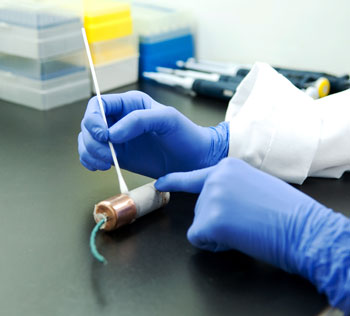 A forensic technician collects biological material from a pipe bomb. Courtesy/Forensic Science Program, PSU
A forensic technician collects biological material from a pipe bomb. Courtesy/Forensic Science Program, PSU
NIST News:
A new handbook by the National Institute of Standards and Technology (NIST) and the Department of Justice’s National Institute of Justice (NIJ) provides forensic laboratories, law enforcement agencies and the judicial system with state-of-the-art guidelines and recommended best practices for preserving biological evidence so that it is available at any time to solve “cold cases,” confirm the guilt of criminals or exonerate the innocent.
Biological evidence refers to two types of evidence commonly recovered from crime scenes or collected during criminal investigations: samples of biological material—blood, semen and other bodily fluids; hair; tissue; bones and teeth—or items containing biological material such as a bloody T-shirt.
The Biological Evidence Preservation Handbook: Best Practices for Evidence Handlers (NIST Interagency/Internal Report 7928) is designed to help ensure that this evidence has been properly stored to avoid contamination, premature destruction or degradation, and accurately tracked to prevent loss.
It was authored and edited by the Technical Working Group on Biological Evidence Preservation, a group of 20 experts from various forensic, law enforcement and scientific disciplines, as well as legal scholars, medical personnel and representatives of relevant professional organizations.
The handbook is divided into five main sections that explain the issues, offer guidelines and make recommendations related to:
- Retention—identifying what biological evidence should be kept and for how long;
- Safe handling—including the use of protective equipment, the management of spills or accidents, and methods for properly disposing waste;
- Packaging and storing—outlining the conditions for storage and how to properly package biological evidence to maintain its integrity;
- Chain of custody and tracking—a review of the different evidence-tracking methods available and procedures for improving all aspects of chain-of-custody recordkeeping; and
- Disposition—summarizing the best practices for disposing of biological evidence once retention is no longer required by law.
While most of its recommendations concern the physical storing, preserving and tracking of evidence at a specific storage facility, the handbook also covers transferring material between a storage facility and other locations and discusses how evidence should be handled at these different sites.
Complementing the five main sections of the handbook are a summary of all recommendations made, a table showing the functions and capabilities of evidence tracking and management systems, a state-by-state listing of evidence retention laws, a sample chain-of-custody report and a glossary.
NISTIR 7928 may be downloaded at http://nvlpubs.nist.gov/nistpubs/ir/2013/NIST.IR.7928.pdf. Print copies are available upon request from the National Criminal Justice Reference Service at https://www.ncjrs.gov.

